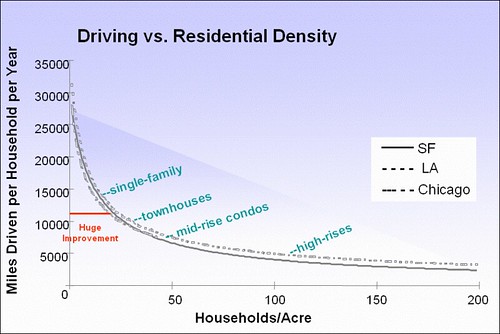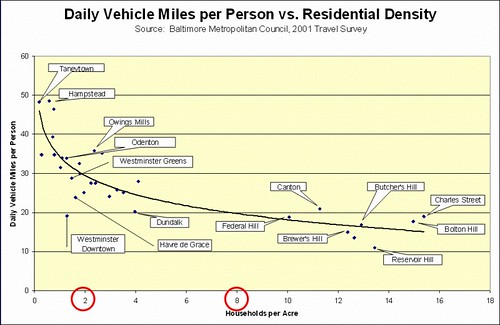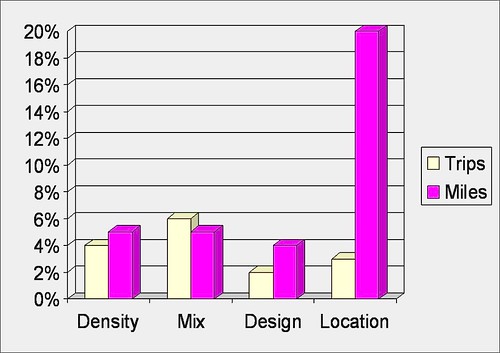Considering the role of density in smart growth

Posted April 28, 2009 at 1:38PM
Later this week, I am going to be participating with my friend David Dixon and marketing whiz Laurie Volk in a seminar on development density at the annual meeting of the American Institute of Architects. Our session is titled "Making Density Work: Dollars, Design, and Sustainability - the Nuts and Bolts of Successful Density." I think Laurie is "Dollars," David is "Design," and I am supposed to be "Sustainability."
Which is fine with me. So, anyway, I have been pondering what it is that I want to say about density and sustainability. The research certainly suggests that it makes a difference. The graph below compares residential units per acre to annual driving rates, as measured in Chicago, Los Angeles, and San Francisco:
Note that, as you move from low density sprawl on the left to high density on the right, driving goes down a lot. This graph has become somewhat of a classic in the field, representing research by John Holtzclaw, my NRDC colleague David Goldstein, and their partners at the Center for Neighborhood Technology.
What I find most intriguing, though, is not the drop in driving rates per se but how much they drop as we change densities. Look at the shape of the curve. We get the greatest increments of performance improvement at the lower end of the scale, as we move from large-lot sprawl to smaller-lot single family homes and townhouses. By the time we reach typical multi-family densities, the curve really flattens out.
So increased density is associated with reduced driving, but we don't need major changes to realize significant benefits. This is especially the case when you realize that it is average density that matters: we can still have some large lots, as long as they are mixed with smaller ones and apartments to produce a performance-changing result.
Here's a graph comparing neighborhoods in Baltimore, very similar in shape to the one above, but looking only at the lower end of the density scale, from large lots on the far left to townhouse-sized lots on the far right:
Note that a change in density from ½-acre lots to 8 single-family houses per acre (see photo just below) is associated with a 33 percent reduction in driving in Baltimore.
Every now and then I read or hear someone whine that smart growth advocates "want to cram everyone into high-rises at transit stations," when that is far from the truth. There are certainly highly urban locations where high-rises are appropriate, but mostly I would just like to see us allocate land more efficiently for single-family houses.
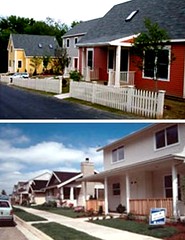 But there's something else going on with density research. Neighborhood density works best when combined with synergistic elements such as location, transit service, connected streets, and mixed land uses.
But there's something else going on with density research. Neighborhood density works best when combined with synergistic elements such as location, transit service, connected streets, and mixed land uses.
In fact, without some of these elements, it won't work very well at all. Density appears to work well in the research, but almost all of the good density studies have been done at macro levels in places, or in areas that include places, that have been built for some time. And, in America, the density tends to be in the older parts of our cities and suburbs, most of it from the pre-sprawl era. Those are also the places that are centrally located, have smaller, well-connected blocks, shops and services nearby, and decent transit service. So the density studies are actually measuring more than density.
The most sophisticated work that I have seen that attempts to separate some of these elements from each other comes from the highly regarded transportation consultancy Fehr and Peers, as represented on the graph below. For each of the four factors represented, a doubling of intensity will reduce vehicle travel, on average, by the percentages shown:
Note that the most important factor in influencing travel behavior is location, or more precisely something called regional accessibility, the distance from a given place (say, a residence) to other important places (jobs, shopping, entertainment, other residents) in the same metro region. This measure is highly favorable to central locations. This is why the GIS-derived map of the distribution of carbon emissions from transportation in metro Portland that I have shown before indicates such large differences between central and outlying locations in their carbon footprint.
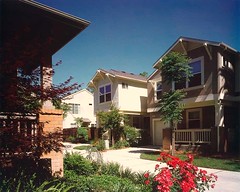 Or, as John Holtzclaw once put it to me in email, a high-rise in the middle of a cornfield isn't going to work for travel efficiency. My take is that we should put the density in town if we want results, and add walkable blocks and a diverse mix of uses.
Or, as John Holtzclaw once put it to me in email, a high-rise in the middle of a cornfield isn't going to work for travel efficiency. My take is that we should put the density in town if we want results, and add walkable blocks and a diverse mix of uses.
Incidentally, I have reason to believe that the Fehr and Peers formulas are in the process of being updated, and that the new version will also tease out the effect of transit service among the factors. Transit will emerge as the second most influential factor after location.
Really, all this just confirms something I have always believed: smart growth is not a principle, but a set of principles. The best results come when they are applied together, and that will be my message on Friday.
